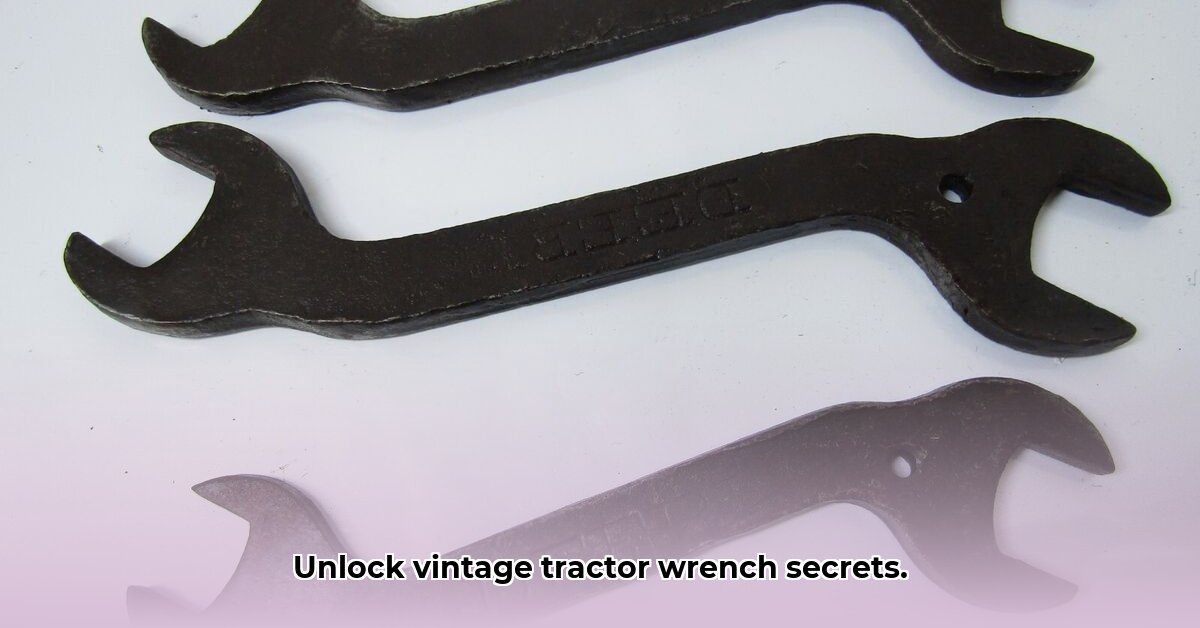
Ever stumbled upon a hefty, oddly shaped wrench in an old barn or antique shop? These aren't just rusty tools; they're historical artifacts whispering tales of farm life's past. This comprehensive guide explores the world of old tractor wrenches, guiding you through identification, valuation, care, and collecting. For even more information, check out this helpful resource: Old Tractor Wrenches Guide. Whether you're a seasoned collector or a curious novice, prepare to appreciate the surprising history and value hidden within these unassuming pieces of metal.
The Story Behind the Spanner: A Look at Old Tractor Wrenches
Imagine a time before power tools. A farmer's success relied on skill and sturdy tools, like the incredibly durable wrenches forged from wrought iron. These early wrenches were built to last, simple yet strong, designed for years of tough use. As technology advanced, drop-forged steel became the material of choice, enhancing strength and durability. Subtle variations exist among manufacturers and tractor models; a vintage John Deere wrench differs significantly from an International Harvester one, reflecting each manufacturer's unique design philosophy. Examining these differences is like tracing the evolution of farm machinery itself. The size and style of the wrench head reveal its intended use and the type of tractor it served. Some have open-ended jaws, others box-ended—each design specialized for specific tasks. The weight of the wrench in your hand speaks volumes about the craftsmanship and elegance of its function.
Spotting the Real Deal: Identifying Authentic Old Tractor Wrenches
The collecting world is plagued by reproductions and fakes. Distinguishing a genuine vintage wrench from a cleverly crafted imitation is crucial. Authentic wrenches bear the marks of age and use. Look for a patina—a lovely, aged surface indicative of years of honest work. The wrench's jaws should display wear, not a pristine, unused finish. Markings are crucial clues. A genuine wrench displays deeply stamped manufacturer's logos and size markings, consistent with the manufacturer's style. Fakes often feature faded, inconsistent, or shallow stamping. Is the marking clear and deep, or fuzzy and indistinct? This difference is paramount.
Judging the Condition and Calculating the Value
A wrench's condition significantly impacts its value. A pristine, perfectly preserved wrench in its original finish commands a higher price than one with significant rust or damage. Yet, a well-used wrench can be valuable, especially if rare or linked to a specific tractor model or manufacturer. Online resources and collector communities provide insight into current market trends. Rarity, manufacturer, condition, and unique features all influence value. Provenance—the wrench's history—can significantly increase its worth. The story behind the wrench adds considerable appeal. How much might a rare, fully restored wrench fetch compared to a heavily rusted one? This difference in condition can often dictate a wrench's worth, potentially spanning from a few dollars to hundreds.
Giving Your Old Tractor Wrench Some TLC: Cleaning and Maintenance
Proper care preserves a wrench's beauty and longevity. Avoid harsh abrasive cleaners; they damage the finish. Use a soft brush and mild solvent to remove dirt and grime. For stubborn rust, a chemical rust remover might be necessary, but always follow the manufacturer's safety instructions. After cleaning, apply a light coating of preservative oil (like light machine oil) to prevent corrosion. Store wrenches in a cool, dry place away from humidity and extreme temperatures. A climate-controlled environment is best, protecting them from the elements. What's the best way to eliminate stubborn rust without damaging your vintage wrench? Gentle cleaning with appropriate tools and solutions is crucial.
The Hunt Begins: Sourcing and Buying Old Tractor Wrenches
Several avenues help expand your collection. Online auction sites are excellent resources, but always inspect listings and photos thoroughly. Don't hesitate to question sellers. Antique tractor shows and swap meets provide hands-on examination of potential acquisitions. Local antique stores and flea markets can yield surprising finds. Patience and a keen eye are invaluable. Be prepared for research! How can you increase your chances of finding a rare vintage wrench? Attending specialized shows and markets, and diligently searching online marketplaces, are key strategies.
Showcase Your Collection: Displaying Your Old Tractor Wrenches
Displaying wrenches is about more than storage; it's about sharing their stories. A simple shadow box showcases individual wrenches, highlighting their unique shapes and markings. For larger collections, a dedicated display case offers protection and enhances visual appeal. Include labels detailing each wrench's model, manufacturer, and historical background. Your collection becomes a captivating historical display.
Authenticity Checklist for Old Tractor Wrenches
| Feature | Genuine Wrench | Reproduction Wrench |
|---|---|---|
| Markings | Deeply stamped, consistent with manufacturer | Shallow, inconsistent, or possibly absent |
| Patina | Even, aged appearance; signs of past use | May appear artificially aged or too uniform |
| Material | Correct type of steel for the era | May use incorrect or inferior materials |
| Weight | Feels substantial and appropriate for the size | May feel lighter than expected |
| Condition of Jaws | Shows signs of use, but no major damage(unless noted) | May show little or no wear; possibly too perfect |
Collecting old tractor wrenches is a journey into agricultural history. These aren't mere tools; they are tangible pieces of the past, each with a unique story. Enjoy the hunt, appreciate the craftsmanship, and preserve a piece of our shared heritage.